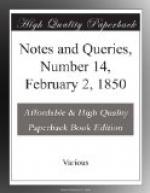In 1792, an ingenious and enterprising architect, James Burton, began to erect a number of houses on the Foundling Hospital estate, partly in St. Giles’s and Bloomsbury parishes, and partly in that of St. Pancras. Baltimore House, built, towards the northeast of Bedford House, by Lord Baltimore, in 1763, appears to have been the only erection since Strype’s survey to this period, with the exception of a chimney-sweeper’s cottage still further north, and part of which is still to be seen in Rhodes’s Mews, Little Guildford Street. In 1800, Bedford House was demolished entirely; which with its offices and gardens, had been the site where the noble family of the Southamptons, and the illustrious Russells, had resided during more than 200 years, almost isolated. Hence commenced the formation of a fine uniform street, Bedford Place, consisting of forty houses, on the spot; also, the north side of Bloomsbury Square, Montague Street to the west, and one side of Southampton Row to the east. Towards the north, the extensive piece of waste ground, denominated the Southampton Fields, was transformed into a magnificent square, with streets diverging therefrom in various directions. Thus, as if by “touch of magic wand,” those scenes, which had been “hideous” for centuries, became transformed into receptacles of civil life and polished society.
The latest account of these footsteps, previous to their being built over, with which I am acquainted, is the following, extracted from one of Joseph Moser’s Common-place Books in my possession:—
“June 16. 1800.—Went into the fields at the back of Montague House, and there saw, for the last time, the forty footsteps; the building materials are there ready to cover them from the sight of man. I counted more than forty, but they might be the foot-prints of the workmen.”
This extract is valuable, as it establishes the period of the final demolition of the footsteps, and also confirms the legend that forty was the original number.
EDWARD F. RIMBAULT.
* * * * * {218}
QUERIES ANSWERED, NO. 4.—“POKERSHIP”, BY BOLTON CORNEY.
A query made by so experienced a writer as the noble historian of Audley End, cannot admit of an easy solution; and instead of professing to answer the two-fold query on pokership, it might more become me to style this note an attempt to answer it.
In the Historical collections of the noble families of Cavendishe, etc. the passage which contains the doubtful word is printed thus:—
“He [Sir Robert Harley, of Bramton, Herefordshire] was in the next year [1604], on the 16th of July, made forester of Boringwood, alias Bringwood forest, in com. Hereford, with the office of pokership, and custody of the forest or chace of Prestwood, for life.”
Are we to read parkership or pokership? If pokership, what is its meaning?




